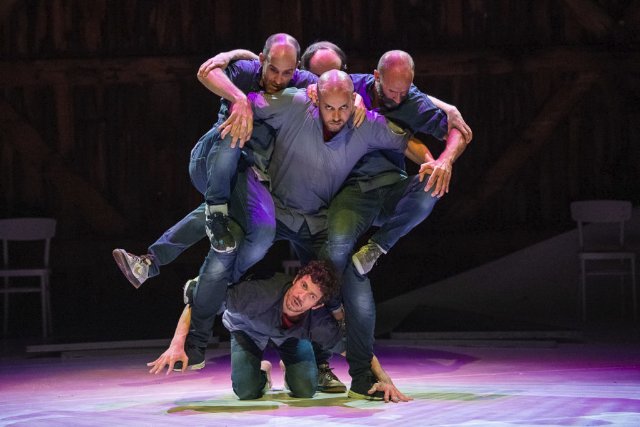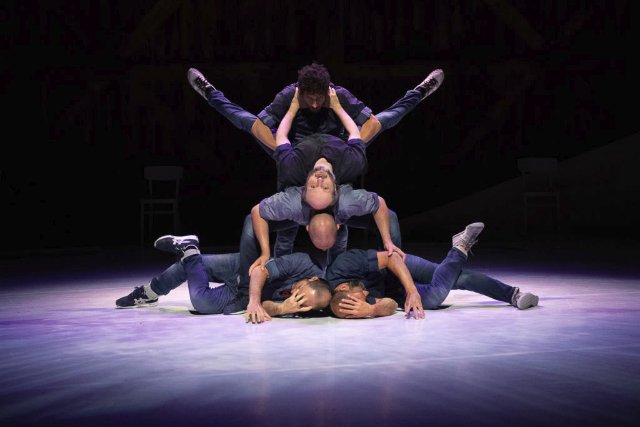Intersectionality of Sidi Larbi Cherkaoui
Elevated Threat Level of Fractus V at Jacob’s Pillow
By: Charles Giuliano - Jul 15, 2018
Sidi Larbi Cherkaoui/ Eastman
Ted Shawn Theatre
Jacob’s Pillow
July 11-15, 2018
Fractus V (2015)
By Sidi Larbi Cherkaoui
Music: Sidi Larbi Cherkaoui, Siumik Datta, Johnny Lloyd, Woojae Park, Shogo Yoshii
Vocal coaches, Christine Leboutte and Steve Dugardin
Set design, Herman Sorgeioos and Sidi Larbi Cherkoui
Costumes, Sumire Hayakawa; Lighting, Krispin Schuyesmans; Sound, Jef Verbeek
Musicians; Soumik Datta, Kaspy N’dia, Woojae Park, Shogo Yoshii
Dancers; Sidi Larbi Cherkaoui, Dmirti Jourde, Shawn Fitzgerald Ahern, Johnny Lloyd, Fabian Thome Duten, Patrick Williams Seebacher (TwoFace)
The week of performances by the Belgian based company Sidi Larbi Cherkaoui/ Eastman featured a single work Fractus V (2015).
In the spirit of intersectionality which informs the cutting edge of performance art it conflates the dance and musical traditions of its diverse members. With elements of text about resistance to propaganda, and misinformation of maniuulated media extracted from Noam Chomsky, there was a polemical social and political edge to the powerful, inventive and strident piece.
Elements ranged from freeform quotation of global traditions to passages that were specific, explicit, and didactic. There was a masculine sensibility that snuffed romance and sentiment and at times was redolent of testosterone to the edge of machismo.
This ranged from subtle and sublime, a passage of Flamenco, to the worst instances of masculine violence with brutality, bullying and murder. There was a lot of shock and a recoil from mayhem that seemed forced and excessive.
In the beating and shooting incidents, for example, the brutality went on and on well after the audience got the point. We see the red headed dancer, Shawn Fitzgerald Ahern, lurch and recoil after being shot at point blank range. The crack of pistols from two assailants is accented by drum beats. At first single shots and then a staccato hail of bullets.
There is riveting invention of music and movement. The company has an unique vocabulary primarily derived from the global diversity and traditions of its members. Rather than formed into a blend there is the impact of an assemblage of individual passages and at times disruptive components. There are intervals that overreach becoming disruptive and taxing.
There is, for example, a trope of manipulating a number of thick, right angled floor elements. A choreography entails the dancers assembling then breaking down and reconfiguring them. A reference, perhaps, is to the tectonic shifts of plates in the earth that result in tremors and disruptions often of a catastrophic nature. But this is overplayed and resultantly seems pointless. In one configuration they are set on vertical edge creating a semi circular enclosure.
Seated at one end Cherkaoui appears to be stressed and seeking distraction. Staring straight ahead he uses an imagined clicker to surf TV. When that doesn’t satisfy he leafs through a magazine. Ever more frustrated he covers his face with it, places it on his head opened up like a scarf, and even stuffs it in his mouth. This is a distraction from the dancer being shot. Ending this sequence the victim lurches and bangs into the end of the vertical triangular elements. They topple in a domino manner the last of which bangs into the seated Cherkaoui who is smashed forward.
Perhaps that's an analogy or a Chomsky metaphor of how an individual seeking the distractions of mass media is directly impacted by an isolated catastrophic event. Gang violence and police killings are not remote and impact all of us individually. The philosophical hypothesis is that we are not blameless from what Hannah Arendt described as the banality of evil.
Much of Fractus V is dark and troubling but also intriguing. There is the unmitigated joy in its celebration of music created with an ecumenical mélange of exotic (for a Western audience) instruments and voices. The traditions conflate Spain, India, Japan/ Korea, and Africa. We recognize the koto a long, narrow stringed instrument which is played by crouching over it. The musicians are set up on flats on opposite side of the stage. A musician plays an Indian instrument which resembles a sarod or lute. The drummer, using what appear to be Japanese instruments, also plays Japanese flute. There are vocal passages with both a soloist and times the entire company.The language was unfamilar so it was felt as a sound withouth explicit meaning.
The evening begins and ends with the dancers on chairs in a line at the back of the stage. It evoked a minstrel tradition as an individual performs as the rest look on. We view the individual specialties of the dancers.
While movement and style varies there is a gender commonality. That’s enforced by the costume design of Sumire Hayakawa. In jeans and dark, simple shirts they look more like construction workers than artists.
This is blue collar, not traditional dance, by seemingly a bunch of guys. There are a lot of street references with elaborate hand movements, and twisted body movements associated with break dancing and hip hop. Much of this is of elusive provenance.
Then there are very specific elements. While those platforms are placed to define and confine his space Fabian Thomé Duten executes a freeform variation of flamenco. He appears several times as a featured dancer for the company. Later his shirt is pulled off revealing the fine tuned body evoking a drawing by Michelangelo for the Sistine Chapel. We were surprised when he was joined by Cherkaoui for a duet of Spanish footwork.
In a references to a multi-armed Indian or Tantric god the group formed a line facing us. There was a play of overlapping arm gestures and an illusion of coming from a single body. They then broke away from that.
There were passages that recalled elements of what we have seen this season. Like Pilobolus the dancers rolled over each other and grouped into a complex single mass. Some of the breakout, frenetic freestyle episodes recalled the Gaga technique. It is impossible to say if that was deliberate or just a reflection of the zeitgeist of contemporary dance.
Evoking another tradition the drummer/ flute player led the ensemble in the African American street tradition of hand jive or hambone. That entails making percussive sound by clapping and slapping the body.
It was an intriguing and eclectic evening that left one evaluating the relationship of the whole performance to the sum of its parts.


